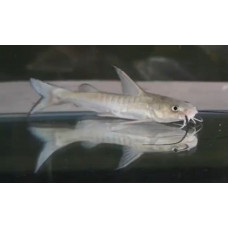Latin name
Hexanematichthys sagor
Other name
Sagor sea catfish, Sunda sea-catfish, marine catfish, dusky catfish.
Identification
The species was described by Francis Buchanan-Hamilton in 1822, originally as part of the genus Pimelodus.
Features of fish fins
Dorsal spines (total): 1; Anal spines: 0.
Fish colouring
The body of this fish is silvery gray.
Distribution
These fish are found in many areas of the Indo-West Pacific Ocean: Pakistan, west and east coasts of India, Bangladesh, Myanmar, Thailand, Malaysia, Singapore, Indo-Australian archipelago (but not in Papua New Guinea or Australia). China and the Philippines have also been recorded.
Habitat
Tropical marine benthic amphidromous species. Lives in estuaries and freshwaters.
Size
This species has a maximum total length of 18 inches (45 cm), but most commonly reaches 12 inches (30 cm).
Behavior
Found along the coast, especially in estuaries. Rise to freshwater in the upper intertidal zone.
Food and feeding habits
The diet of the catfish consists of fish and benthic invertebrates.
Reproduction
They carry the eggs in their mouths. Juveniles continue to hide in males' mouths for the first 2 months.
Fishing
Sagor catfish are harvested commercially and for aquarium culture.
Relationship with a person
The flesh of these fish is sold fresh.
Traumatogenic for humans.
| Classification | |
| Phylum | Chordata |
| Class | Actinopterygii |
| Squad | Siluriformes |
| Family | Ariidae |
| Genus | Hexanematichthys |
| Species | H. sagor |
| Features | |
| Conservation status | Not Evaluated |
| Habitat | Bottom |
| Life span, years | No information |
| Maximum body weight, kg | No information |
| Maximum length, cm | 45 |
| Sailing speed, m/s | No information |
| Threat to people | Edible |
| Way of eating | Predator |
Sagor catfish
Tags: sagor catfish



